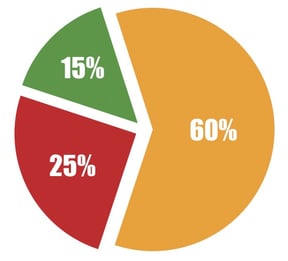Work. Shouldn’t. Suck.
Big Ideas | Culture | Employee Engagement | People Operations | Human Resources
Why People Ops Can’t Wait Until Tomorrow

This piece details a core belief of mine, and why, especially if you’re a leader in the cultural sector, I believe you should share it too.
Strategic HR — or People Operations — is a senior-level management competency that needs to be embedded in every decision we make in our organizations.
Why do we need to think strategically about our People Operations and embed it in everything? Why can’t we just give it to the “HR person”? Well, because this, for one reason:

Gallup’s Worker Engagement Index found that, globally, only 15% of employees are engaged. Engaged employees are those with passion and who feel a profound connection to their company. They drive innovation and move the organization forward.

That leaves a whopping 85% of employees who are not engaged. Sixty percent of total employees are disengaged and essentially checked out. They’re sleepwalking through their workday putting time — but not energy or passion — into their work. And then there’s… wait for it… 25% of total employees who are *actively* disengaged — WOWZA!! That’s a quarter of employees who aren’t just unhappy at work, they’re busy acting out their unhappiness. Every day, these employees undermine what the 15% of engaged coworkers are trying to accomplish.
We have almost *double* the number of people actively working against us as working *for* us — inside our own organizations!
(I’m just going to pause to let that fun fact sink in.)
In letting this happen, we’re effectively setting a whole host of organizational resources on fire. All of those hard-fought resources you’ve been struggling to obtain and maintain? Poof, up in smoke. If you like money, think of it this way: Congratulations on receiving that $100,000 grant… minus the 85% disengagement tax… that leaves $15,000. Hope it was worth all the hard work.
Maybe those percentages are bearable if your organization has 50, or 100, employees — inertia in large organizations is a powerful force allowing some to operate incompetently for too long — but this is *catastrophic* when we consider that the vast majority of our cultural sector organizations are operating with fewer than 10 staff members. You, leader who is reading this, might be the only employee in your organization who is engaged, which means you have even more of a responsibility to do something about it.

Before we explore how to use this information, here’s another fun fact: 51% of our employees are looking for another job. If by now you’re standing in a puddle of tears, I don’t mean for this news to break us down. There’s actionable intelligence we can glean from this group that can help us as we begin to approach our People Ops work more strategically. It might be painful intelligence for us to receive, but it’s necessary to move forward strategically.
Overall, the news from Gallup’s Engagement Index is slightly better for those of us working in the U.S. and Canada. Only 7 of our 10 employees are disengaged instead of 9 of the 10 globally. Even this relatively positive news though results in a kind of stalemate tug-o-war where engaged employees versus the actively disengaged employees tire each other out as they remain locked in place. In this scenario, we’re essentially betting our organizational success on our disengaged staff. (My heart goes out to cultural sector colleagues working in Britain who have 8% engagement, and Japan who have 6% engagement.)
Work shouldn’t suck.
As leaders, we are shirking a core responsibility if we allow this to happen without continually trying to do something about it. And, if after reading the statistics above, you get mad like me and say, “Damn right, work shouldn’t suck for me or anyone else,” then demand that more of our cultural organizations — organizations dedicated to making the world a better, more beautiful place — don’t do it by burning through staff.
Our organizations are chocked full of creativity, let’s harness it to create innovative workplaces — with a sense of shared purpose — where people can do their best work and thrive. That’s the *least* we can do, because doing that affords us the ability to actually change the world while treating employees with respect and humanity.
This creativity can start simply by questioning conventional wisdom and how we’ve always done things. Why do we include that educational requirement line in our job postings? Why are most of our offices essentially replicas of the ones our grandparents worked in 50 years ago? How could we work in ways that better reflect the way people live and work today? How can we demonstrate anti-racist and anti-oppression values in our workplace? When technology gives us access to billions of talented people around the world, why do we still centralize organizations? What’s the purpose of our staff meeting? Is it an effective use of the most expensive meeting our organization regularly holds? Why do we do that thing on an old computer that repeatedly transforms a 60-second process into a 20-minute struggle thereby eating up hours of staff time a week?
If, even after the above, you’re still skeptical that strategic People Ops is worth it, I’ll give you one last data point: research shows people who work in alignment with their motivators — who feel engaged in the work they’re doing — produce higher-quality work, have greater output, earn higher incomes, and are 150% more likely to live a happier life.
Not just for Executives
While my argument is mainly aimed at senior leadership and organizational decision makers, the responsibility doesn’t rest solely on their shoulders alone. People Ops, and great company culture that permeates the entire organization, isn’t possible if it’s just the Executive Director. You can lead from wherever you currently find yourself in an organization. Leaders can be separate from from managers, supervisors and executives. Some of the people in those positions aren’t leaders. And vice versa, a person on the bottom rung of a hierarchical org chart can be a culture carrier and leader within their organization and influence its trajectory more than formal leaders. With this in mind, what can we all do about the disheartening figures above that impact us all?
Start Somewhere, Anywhere
Don’t know where to start? Start by imaging a place where your most idealistic self would love to work and where you could thrive. Don’t let years of scarcity mentality and “this is how it’s done in non-profit” compromises anchor you to an environment that you merely put up with it. Even if you love your job, there are bound to be things you’d like to change that would make you more engaged. For instance, I love what we’ve built, and are building, at Fractured Atlas, but I’d still love if it was a little more Big Island of Hawai’i adjacent and/or had vistas where I could just stare across them and imagine how we can implement things to be even better.
Again, this doesn’t just need to be all on the shoulders of the organization’s leader. Making People Ops more central to an organization’s strategy and tactics involves everyone in the organization as you explore and identify things large and small. It also doesn’t have to be on level with a total office redesign. Early in my Fractured Atlas tenure, we just wanted a place to wash our lunch dishes that wasn’t the tiny sink in the tiny restroom. Small wins can sometimes make a huge impact in our level of engagement.
If you’re someone who finds yourself in the 85% of disengaged workers, might I suggest looking at Amy Wrzesniewski’s work. Amy’s research focuses on finding meaning in one’s work, and includes a job crafting toolkit to help you create the job you want from the job you have. Or, take a look at Chester Elton and Adrian Gostick’s What Motivates Me assessment. While leaders have a responsibility to help create the environment where great things can occur, we all have a responsibility to own our part of the work.
No one will care more about you and your career than you. You’re the CEO of You Inc.
If you’re stuck and feeling helpless, ask yourself, “What can I do right now to move towards what I really want?” (You have more options than you think.)
Leaders don’t set out to make work suck
Most leaders don’t set out to create and run organizations where work sucks. They, like the regular human beings they are (even if some seem larger than life), are trying to do the best with the hand that’s been dealt. Sometimes we don’t know what we don’t know and that leads us to make wrong decisions, or ones that unintentionally devalue something that has a significant impact on our organization’s ability to deliver on its mission. This isn’t surprising given the Scarcity Trap that snares many non-profit executives. This is why we need to create an environment where everyone owns People Ops, and then continually work to iterate and improve it.
For the health and future of our sector, it’s incumbent upon all of us to make people and People Ops a key consideration in everything that we do. It’s hard work, but it’s not difficult to simply start showing that you care about each other. Unlike the stalemate tug-o-war, there’s no neutral here. We’re either moving forward or falling behind and, if we choose not to engage with this, other organizations will happily eat our lunch.
About Tim Cynova
Tim wears a multitude of hats, all in service of creating anti-racist workplaces where people can thrive. He currently is co-CEO of Fractured Atlas (an entirely virtual organization with staff spread across multiple states and countries) and a Principal of the consulting group Work. Shouldn't. Suck. He serves on the faculty of Banff Centre for Arts & Creativity and The New School teaching courses in People-Centric Organizational Design; he's a trained mediator, and a certified Senior Professional in Human Resources (SPHR). Earlier in his career, Tim was the Executive Director of The Parsons Dance Company and of High 5 Tickets to the Arts in New York City, had a memorable stint with the Cincinnati Symphony Orchestra, was a one-time classical trombonist, musicologist, and for five years in his youth he delivered newspapers for the Evansville, Indiana Courier-Press. Also, during a particularly slow summer, he bicycled 3,902 miles across the United States.


